The amount of sunlight reflected back into space by Earth has fallen noticeably in recent years, as measured by the feeble glow seen on the dark areas of a crescent moon’s face. Scientists say it’s unclear whether the drop in earthshine is a one-time blip or another warning indicator for Earth’s climate.
On average, our globe reflects around 30% of the sunlight it receives. According to Philip Goode, an astronomer at Big Bear Solar Observatory in California, a new analysis backs up prior studies revealing that Earth’s reflectance has been falling in recent years. The Earth’s reflectance decreased by around 0.5 percent from 1998 to 2017, according to a study published in Geophysical Research Letters on Sept. 8.
From 1998 to 2017, Goode and his colleagues measured earthshine — the light that bounces off our planet, to the moon, and then back to Earth — using ground-based devices at Big Bear. The researchers only collected 801 data points during those 20 years because earthshine is easiest to measure when the moon is a thin crescent and the weather is clear, according to Goode and his colleagues.
According to Goode, much of the decline in reflectance happened in the last three years of the two-decade period analyzed. Warmer temperatures around the Pacific coasts of North and South America, he and his colleagues observe, may have contributed to the decline in reflectance by reducing low-altitude cloud cover and exposing the underlying, much darker and less reflecting oceans.

